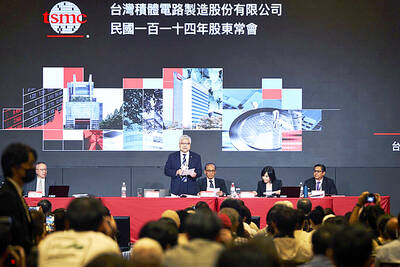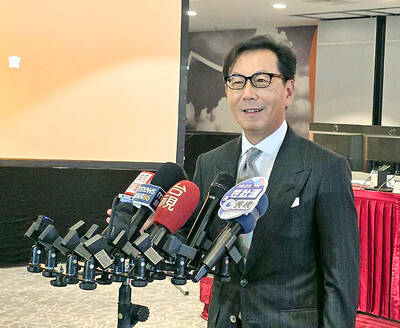United Microelectronics Corp (UMC, 聯電) saw its shares tumble 4.78 percent despite its newly announced collaboration with Intel Corp on 12-nanometer technology, helping the Taiwanese chipmaker secure much-needed advanced chip capacity in the US.
The stock price of UMC closed at NT$49.8 in Taipei, versus the TAIEX’s loss of 0.04 percent and bigger rival Taiwan Semiconductor Manufacturing Co’s (台積電) gain of 0.31 percent yesterday.
UMC has stopped migrating into next-generation technology since 2017, given heavy capital expenditure pressure. Since then, the Hsinchu-based chipmaker has been focusing on offering less-advanced 22-nanometer and 28-nanometer chips.

Photo courtesy of Intel Corp and UMC Corp
However, it is facing rapidly growing competition from capital-rich Chinese peers.
The partnership with Intel would allow UMC to regain its strength in pushing forward its technology capabilities. On Thursday night, UMC said it would team up with Intel to develop 12-nanometer technology to address high-growth markets such as mobile, communication infrastructure and networking.
The long-term agreement brings together Intel’s at-scale US manufacturing capacity and UMC’s extensive foundry experience on mature nodes to enable an expanded process portfolio, the statement said.
It also offers global customers greater choice in their sourcing decisions with access to a more geographically diversified and resilient supply chain, it said.
“Our collaboration with Intel on a US-manufactured 12-nanometer process with FinFET capabilities is a step forward in advancing our strategy of pursuing cost-efficient capacity expansion and technology node advancement in continuing our commitment to customers. This effort will enable our customers to smoothly migrate to this critical new node, and also benefit from the resiliency of an added Western footprint,” UMC co-president Jason Wang (王石) said in the statement.
For Intel, the strategic collaboration with UMC “further demonstrates our commitment to delivering technology and manufacturing innovation across the global semiconductor supply chain and is another important step toward our goal of becoming the world’s second-largest foundry by 2030,” said Stuart Pann, Intel senior vice president and general manager of Intel Foundry Services (IFS).
The 12-nanometer technology node would utilize Intel’s US-based high-volume manufacturing capacity and experience in FinFET transistor design, the statement said. The production would markedly benefit from UMC’s decades of process leadership and history of providing customers with Process Design Kit (PDK) and design assistance for effectively providing foundry services.
The new process node would be developed and manufactured in Fabs 12, 22 and 32 at Intel’s Ocotillo Technology Fabrication site in Arizona. Production of the 12-nanometer process is expected to begin in 2027.
TrendForce Corp (集邦科技), a Taipei-based market researcher, yesterday said the partnership would create a win-win situation as UMC would be able to leverage Intel’s existing factory facilities.
With the collaboration, Intel would take one step further to
expand its foundry services as UMC would play a key role in assisting Intel in negotiating new foundry businesses, in addition to UMC’s 12-nanometer intellectual patents, the researcher said in a report.
“For UMC, this collaboration is a game-changer, allowing it to agilely leverage FinFET capacity without the pressure of heavy capital investments. This move positions UMC to carve out a unique niche in the fiercely competitive mature process market,” TrendForce said.
If this partnership progresses well, Intel might consider expanding their partnerships to one to two more fabs with 1X-nanometer FinFet capacities, likely in Ireland’s Fab 24 and Oregon’s D1B/D1C, TrendForce said.

CAUTIOUS RECOVERY: While the manufacturing sector returned to growth amid the US-China trade truce, firms remain wary as uncertainty clouds the outlook, the CIER said The local manufacturing sector returned to expansion last month, as the official purchasing managers’ index (PMI) rose 2.1 points to 51.0, driven by a temporary easing in US-China trade tensions, the Chung-Hua Institution for Economic Research (CIER, 中華經濟研究院) said yesterday. The PMI gauges the health of the manufacturing industry, with readings above 50 indicating expansion and those below 50 signaling contraction. “Firms are not as pessimistic as they were in April, but they remain far from optimistic,” CIER president Lien Hsien-ming (連賢明) said at a news conference. The full impact of US tariff decisions is unlikely to become clear until later this month

GROWING CONCERN: Some senior Trump administration officials opposed the UAE expansion over fears that another TSMC project could jeopardize its US investment Taiwan Semiconductor Manufacturing Co (TSMC, 台積電) is evaluating building an advanced production facility in the United Arab Emirates (UAE) and has discussed the possibility with officials in US President Donald Trump’s administration, people familiar with the matter said, in a potentially major bet on the Middle East that would only come to fruition with Washington’s approval. The company has had multiple meetings in the past few months with US Special Envoy to the Middle East Steve Witkoff and officials from MGX, an influential investment vehicle overseen by the UAE president’s brother, the people said. The conversations are a continuation of talks that

CHIP DUTIES: TSMC said it voiced its concerns to Washington about tariffs, telling the US commerce department that it wants ‘fair treatment’ to protect its competitiveness Taiwan Semiconductor Manufacturing Co (TSMC, 台積電) yesterday reiterated robust business prospects for this year as strong artificial intelligence (AI) chip demand from Nvidia Corp and other customers would absorb the impacts of US tariffs. “The impact of tariffs would be indirect, as the custom tax is the importers’ responsibility, not the exporters,” TSMC chairman and chief executive officer C.C. Wei (魏哲家) said at the chipmaker’s annual shareholders’ meeting in Hsinchu City. TSMC’s business could be affected if people become reluctant to buy electronics due to inflated prices, Wei said. In addition, the chipmaker has voiced its concern to the US Department of Commerce

STILL LOADED: Last year’s richest person, Quanta Computer Inc chairman Barry Lam, dropped to second place despite an 8 percent increase in his wealth to US$12.6 billion Staff writer, with CNA Daniel Tsai (蔡明忠) and Richard Tsai (蔡明興), the brothers who run Fubon Group (富邦集團), topped the Forbes list of Taiwan’s 50 richest people this year, released on Wednesday in New York. The magazine said that a stronger New Taiwan dollar pushed the combined wealth of Taiwan’s 50 richest people up 13 percent, from US$174 billion to US$197 billion, with 36 of the people on the list seeing their wealth increase. That came as Taiwan’s economy grew 4.6 percent last year, its fastest pace in three years, driven by the strong performance of the semiconductor industry, the magazine said. The Tsai